The Many Flaps of Skanondo Lodge
The Many Flaps of Skanondo Lodge
50 years or 64?
Update: This one goes to 15
Update II: Four S4s and a Spelling Error
Update III: First Fake and Final Farewells
In 2021, Order of the Arrow Lodge Nacha Nimat 86 of the Hudson Valley Council celebrated its 25th anniversary. But maybe “celebrated” isn’t quite the right word – not only were we in the second year of a pandemic that had disrupted every aspect of our lives and killed hundreds of thousands of Americans, but Nacha Nimat’s days were numbered. Effective 1 January 2021, the Hudson Valley Council ceased to exist, replaced by the Greater Hudson Valley Council formed by a merger with the Westchester-Putnam Council. Like Westchester-Putnam’s Ktemaque 15, Nacha Nimat would soon be replaced by a new lodge representing the Greater Hudson Valley Council. The circle of life was now complete.
25 years earlier, financial problems forced a similar merger to form the now-defunct Hudson Valley Council on 1 January 1996. That merger involved the Hudson-Delaware Council, Dutchess County Council, and Rockland County Council and their respective OA lodges Skanondo 64, Nooteeming 443, and Munsi 444. It was amid this backdrop of a new council and new lodge that my Scouting career ended. Officially an Eagle Scout in the Hudson Valley Council (by less than a week), the council and lodge I had known for most of my life no longer existed. You really can’t go home again.
Skanondo Lodge left behind a legacy of hundreds of members and decades of service, but all of that predated the ubiquity of the internet. As a result, little of its history can be found online. All that remains is a fairly small amount of memorabilia and few collectors, the former increasing as the ranks of the latter decrease and their belongings are released back into the wild. The circle of life continues.
Formed in the aftermath of the 1931 merger that brought the Orange County Council and Sullivan County Council together into the Orange-Sullivan Council (renamed the Hudson-Delaware Council in 1958), Skanondo Lodge served Beech Mountain Scout Camp until the Hudson-Delaware Council left at the end of the 1980 camp season and then Camp Ranachqua at Ten Mile River Scout Camps from 1981 to 1995. Its successor lodges have continued its mission with new generations of honor campers.
Lodge Flaps
The lodge flap is a symbol of membership in a particular Order of the Arrow lodge (though not the main emblem designating one as an Order of the Arrow member). Lodge flaps began in the late 1940s after the Boy Scouts of America began integrating the Order of the Arrow into the Boy Scout program. In 1954, BSA declared the right shirt pocket flap as the official location for OA insignia, opening the floodgates to lodge flap production. Much like council strips, which came about in the 1970s, these patches quickly became a favorite of collectors.
Skanondo Lodge issued a total of 20 different lodge flaps over its lifetime, several with notable variations. Three additional flaps were issued by the Hudson Valley Council in 1996 featuring the numbers and totems of its three legacy lodges (but not their names). These are classified alongside the official issues of each legacy lodge. For at least the last dozen years or so of the lodge’s existence (the only time I have information on), regular issue lodge flaps were limited to one per member per event, with the eligible events being the Winter Banquet, June Ordeal, and August Ordeal. Getting flaps to trade involved either attending several events or making friends with people who attended events but didn’t care about lodge flaps and were willing to act as an intermediary in the trading post. The latter method was rarely successful.
Classification and nomenclature is from the Blue Book as explained here – the 2006 edition can be downloaded as text or PDF and the current version is maintained by the International Scouting Collectors Association accessible to members only. Some of the cataloged items can be viewed at OAInsignia and more recent issues can be found in Bill Mulrenin’s NY OA Trader Blog and on PatchScan. Some details are presented as noted in the 1997 printed version of Arapaho II. Errors in these sources will be noted here as appropriate. Skanondo is not yet covered by PatchVault
Historical information presented here is from a mix of sources. Information from 1992 to 1997 is from first-hand experience (mainly 1992-1994) and archived documentation (mainly 1995-1997). Information from several preceding years was obtained second-hand and everything else is from online references or examination of the items themselves. Little or no specific information about Skanondo Lodge is readily available online and I have no current contacts with more information beyond family contacts noted below. So this is going to be pretty light on relevant details. I should probably try to get in touch with the last lodge historian sometime…
To allow for relative size comparisons between items of the same type, pins are displayed at 300dpi, neckerchiefs and jacket patches are displayed at 60dpi, and most other items are displayed at 100dpi. The resolution of each image is appended to the end of the filename for easy reference.
Skanondo 64 F1b (1950s?) – First Flap
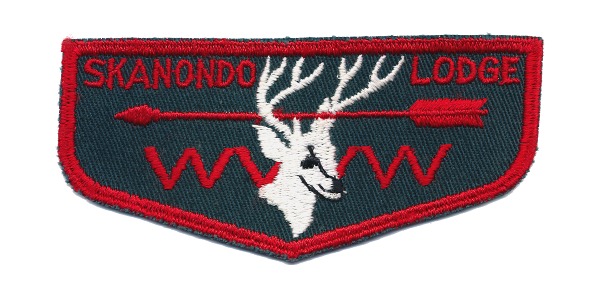
The F1 is the first lodge flap ever issued by Skanondo Lodge. Unlike every flap that follows, it features a cut edge. I have no source for the date of the first Skanondo lodge flap, but we can ballpark it with a look at the timeline (details are from OA-BSA.org):
- 1932 – Skanondo Lodge is formed on 3 October according to Arapaho II
- 1945 – OA patches are approved to be worn on the right shirt pocket (not flap)
- 1948 – The first Order of the Arrow Handbook is published, featuring a photo of the first lodge flap
- 1949 – Skanondo 64 first appears on an OA area list, dated 13 May, according to the Order of the Arrow Conclave Handbook
- 1952 – The Wabaningo Lodge Emblem Handbook is published, showing seven lodge flaps (no Skanondo items are listed). Seven additional lodges are known to have had flaps by this time.
- 1954 – The National Committee on Insignia declared the right shirt pocket flap as the official location for OA insignia.
- 1960 – Ninety percent of the active lodges wore pocket flap badges.
Based on this, it is reasonable to assume that the F1 was issued at some point in the 1950s.
Three documented variations of the F1 exist. The version shown above is the F1b, distinguished from the F1a from the twill direction (up and to the left vs up and to the right for the F1a) and distinguished from the F1c by the disjointed jaw outline (vs. straight for the F1c). The real challenge with the F1 though is distinguishing the F1a from the various counterfeit versions in circulation, such as this:
Skanondo 64 ZF1 (???) – Fake
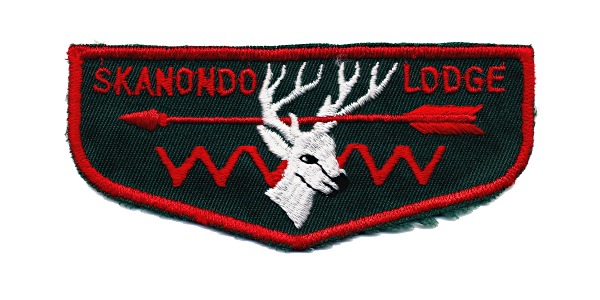
First flaps are particularly sought after by collectors and therefore are typically the most valuable issue for older lodges. This, naturally, makes them a target of counterfeiters. Numerous fakes of the Skanondo F1 have been produced and the extent of this is not entirely known. The first of these is the ZF1, shown above.
Skanondo 64 ZF? (???) – Fake
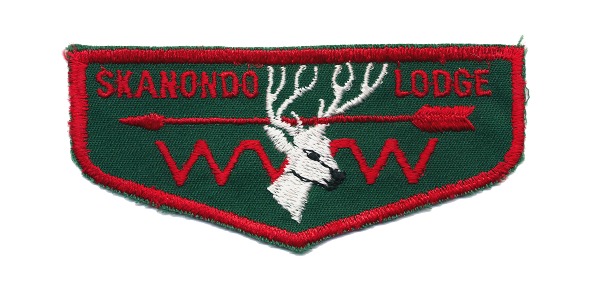
Initially, I had thought that the above flap was the ZF1. As it turns out, there is an uncatalogued fake of the F1a and this and two others of my fakes appear to be of this variety. These actually seem to be based on the ZF1 rather than the F1 itself – a fake of a fake? We may never know how deep this goes…
All of the fakes can be distinguished from the real F1a by comparing the embroidery on the deer – the real one is primarily horizontal, while the fakes are embroidered mainly diagonally.
Skanondo 64 ZF2 (???) – Fake
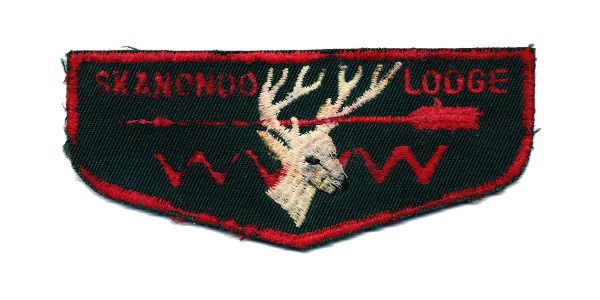
A second fake, the ZF2, has also been documented. In fact, there’s one up on eBay right now with a $200 opening bid (Update: Nobody bit after several attempts, so it was relisted for $240 or best offer – always independently confirm authenticity before purchasing an item like this, many sellers either don’t know or don’t care that they’re selling counterfeit merchandise.) I paid considerably less than that for mine, though it is in Near Disintegrated condition. I was kind of worried that the light from the scanner would turn it to dust…
Skanondo 64 S1a (1960s?) – First Solid
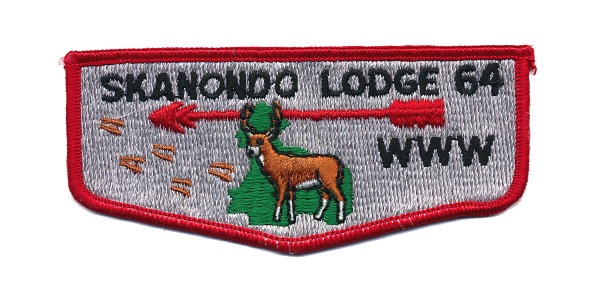
The S1 followed the F1, likely sometime in the 1960s. This is Skanondo’s first fully-embroidered flap or first solid. Like first flaps, first solids are particularly collectible and command a significant premium. And like the F1a, a fake version of this patch exists, the ZF3. It’s not fully embroidered, has a cut edge instead of a rolled edge, and is a generally laughable attempt at a counterfeit.
Two variations of the S1 are documented, the S1a with a flat rolled edge and the S1b with a regular rolled edge. No visual comparisons are available online, so I am just guessing that this is the S1a based on the position of the lock stitch in the upper right corner.
A silk screen version of this design was used to produce neckerchiefs (Blue Book designations N1a and N1b) and the design was reused in a different format for the S2, shown below.
Skanondo 64 S2 (1960s?)
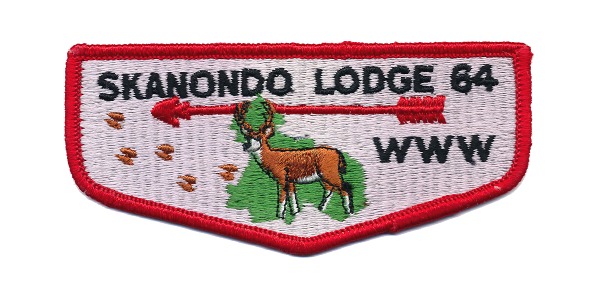
Like the S1, the S2 is a fully-embroidered flap showing a full deer superimposed over an approximation of the shape of the Hudson-Delaware Council (Orange, Sullivan, and Pike Counties) with a set of tracks in front. The simplest way to tell the S2 from the S1 is by the direction of the background embroidery – horizontal for the S2 and vertical for the S1. The flap shapes are also notably different and the embroidery is completely different.
This is the oldest Skanondo Lodge flap commonly available on the secondary market. It is effectively worthless but is a nice piece of history all the same. It was likely in use until 1970 based on the next flap.
Skanondo 64 S3a (1971) – 25 Years of Service 1946-1971
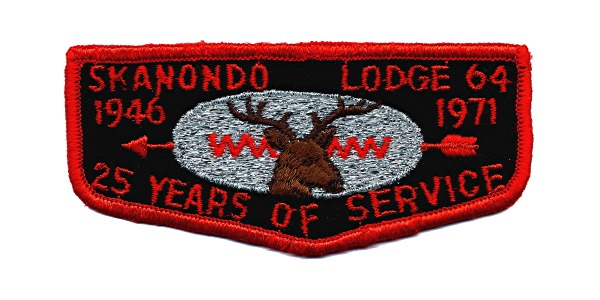
Skanondo 64 S3b (1971) – 25 Years of Service 1946-1971
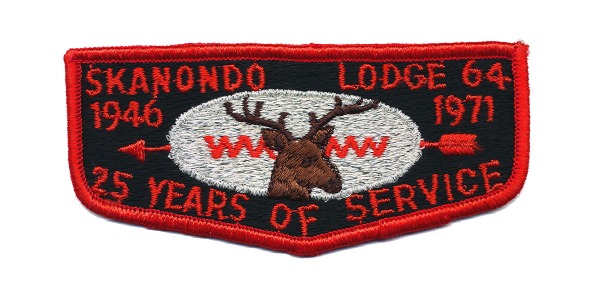
The S3 is the first Skanondo flap with a definite date. And it also comes with a bit of a mystery – what anniversary is this celebrating? I had always assumed that it was a reference to when the lodge was formed, something that following flaps both agree and disagree with. The accepted chartering date of 1932 for lodge #64 lines up with the known number of lodges at the time (50 in 1930 compared to more than 300 by 1946), so there’s no reason to doubt that date.
So what happened in 1946? The closest major milestone is the Order of the Arrow being fully integrated into BSA in 1948. And after being chartered, there seems to have been no record of Skanondo Lodge at the national level until 1949 (as per the timeline established above). Beech Mountain Scout Camp can’t be a factor either – it opened more than 30 years earlier in 1940, 8 years after the lodge was founded. There’s no clear reason why Skanondo would be celebrating “25 Years of Service” in 1971.
Incidentally, Skanondo’s neighbor to the north, Half Moon 28, celebrated its creation as 1946 (it was rechartered from an earlier lodge, hence the lower number). This also seems to have been in error, as the currently accepted rechartering date is 1947. Is there a connection or is this just a random coincidence? Just wait until we get to talking about council strips…
What isn’t a mystery is that Skanondo Lodge hosted the Area 2H conclave in 1971 at Beech Mountain Scout Camp. This is the first of five Skanondo-hosted conclaves that I am aware of and the only one for Area 2H – Areas were reconfigured into Sections starting in 1973 (a mention of Skanondo hosting Area 2A in, fittingly, 1964 can be found at OASections.com, but nothing in the event logo references Skanondo or Beech Mountain and I have not found any other references). A silk screen version of this design was used for the event neckerchief (which has no Blue Book designation because the Blue Book specifically excludes conclave issues) and “Service Troop” neckerchiefs (Blue Book designations N1.5 and N1.7).
Two variations of the S3 are documented – the S3a with gray thread mixed with silver mylar thread in the oval and the S3b with white thread instead of gray. The difference is plainly obvious from the front if the white balance is set properly. It is easier to distinguish the variations when viewing the back, where there is white thread visible elsewhere on the patch. If the thread in the oval matches the other thread, it’s the S3b. If the thread in the oval is darker, it’s the S3a.
Skanondo 64 F2a (1970s)
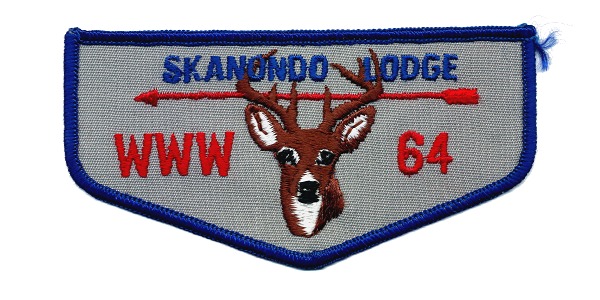
And now we get into the era I have some sort of connection to. The next three issues take a back-to-basics approach and give a modern (for the 1970s) update to the classic “arrow through the antlers” design of the first flap. These all feature a bare twill background, rolled edge, and elaborately embroidered (compared to the F1) deer head.
These were issued during the 1970s, when my father was an adult leader with Troop 17 in Newburgh, NY. The F2b and F3a shown here are from his collection. And by “collection,” I mean stacks of brand-new flaps still in the original (no longer sealed) plastic. I don’t know why he had so many of them, but I learned long ago not to ask questions about where the things he brought home came from.
Skanondo 64 F2b (1970s)
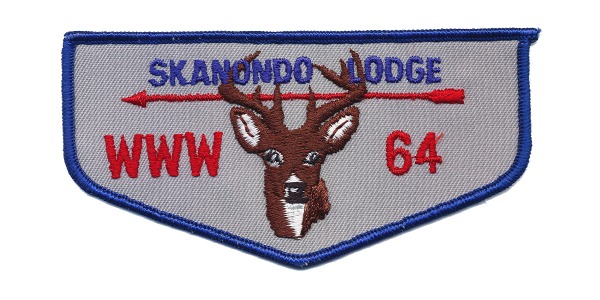
Two variations of the F2 have been documented – the F2a has a nondirectional twill background while the F2b has a twill background with grain running up and to the right. The F2b is among the more common Skanondo flaps available on the secondary market.
Skanondo 64 F3a (1970s)
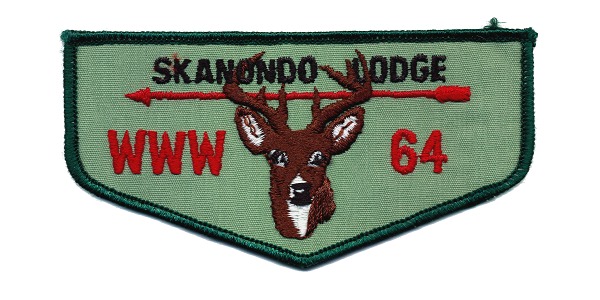
If the F3 looks familiar, it’s because the embroidery is identical to that of the F2 with the exception of the color of thread used for the lodge name. In fact, the F2b and F3a shown here might as well have been manufactured in the same production run. Other than the color of the name, the only differences are the border and background colors.
Skanondo 64 F3b (1970s)
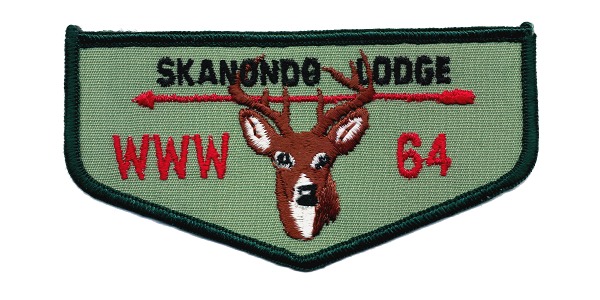
As with the F2, the F3 has two documented variations. The F3b differs only in the brown used for the deer, which is slightly lighter than that of the F3a. Differences in embroidery may just be due to minor manufacturing variations and are not notable.
Skanondo 64 F4 (1970s?)
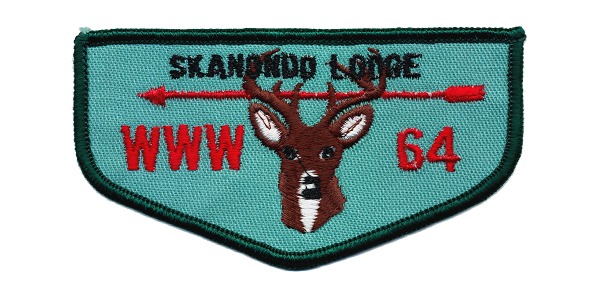
Ah, the F4, the alpha and the omega. For my collection, at least. This is the flap that started me down my journey toward a complete set of Skanondo Lodge flaps and was the final piece I needed to reach the end. The story begins nearly 30 years ago…
I first received a lodge flap, the S9, in June of 1992. Now finally a member of the group that my father and brother had previously been a part of, the lodge’s history was of more significance to me. A display mounted on the wall in the lodge at Camp Ranachqua held various artifacts from the 70-year history of Council 392 (with my father listed as one of the contributors), mainly council strips and lodge flaps. The council strips were mostly rare variations of the strip we all wore, but the lodge flaps were more varied and reached further back in history. I was already familiar with everything between the 1971 and 1990 issues with one exception – the F4.
What was this thing? It looked somewhat like the previous two flaps, but something was off. The color was off. The shape was off. The embroidery was off. Everything was off. And I had never seen it before. I wanted it. I needed it. But I didn’t know anyone who had one. I could accept that the older patches could be out of reach, but not this. This posed a problem.
eBay presented a possible solution at the end of the decade. So I watched and waited. And waited. And waited. Along the way, I found every other patch on this page that I couldn’t get from the lodge, from my brother, or from my father’s stash. Everything except the F4. My searches became less frequent as the decades wore on. Finding one seemed like a fantasy.
And then there it was. I almost missed it, but something in the sea of F3s seemed off. That almost looked like a… No, it couldn’t be. The colors matched. The shape matched. The embroidery matched. This was it. All for less than $10. Could this be real?
It could, and it was. And it had been listed before. And another one had recently ended without any bids. Twice. 20 years of searching, 30 years of wanting, and now I was leaving one behind. Nobody else wanted one. How long has it been? Nearly 26 years since the end of Skanondo Lodge. It had been forgotten. But with the F4, I could make sure that something would be remembered. I could finally tell this story, incomplete as it is from just my perspective. Now it could all fall into place.
Skanondo 64 R1 (1970s)
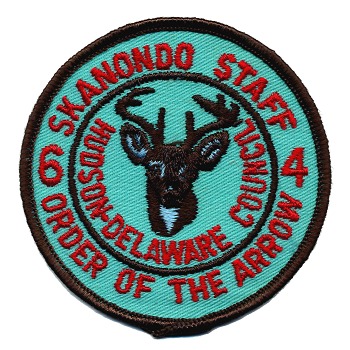
The same design used for the F2-F4 was also used on a “Skanondo Staff” 3″ round in colors most closely resembling the F4. I do not know what the purpose of this patch was, but it could be related to the 1976 Section NE-3A Conclave hosted by Skanondo Lodge at Beech Mountain Scout Camp. The timing fits and the lack of any memorabilia connecting Skanondo to this conclave is odd.
Skanondo 64 S4a – Cloth Back, GRN Trees (1980s)
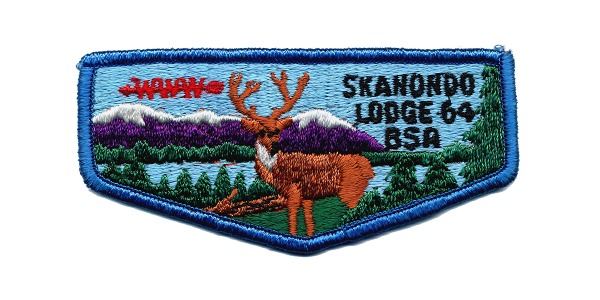
Skanondo 64 S4b – Plastic Back, GRN Trees (1980s)
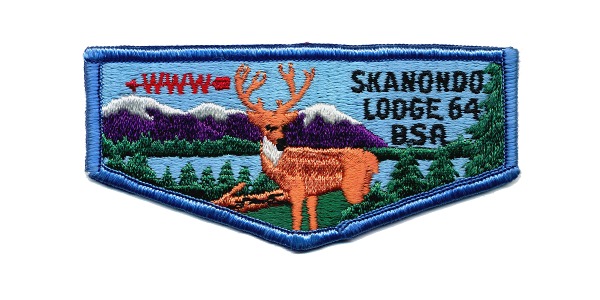
Skanondo 64 S4c – Cloth Back, DGR Trees (1980s)
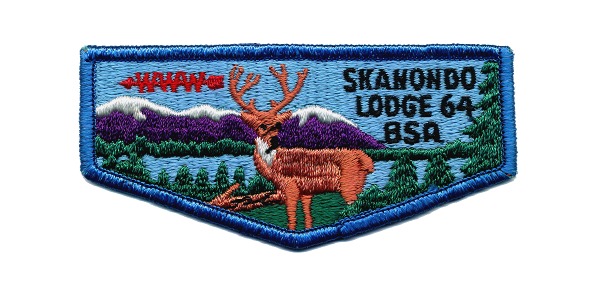
Skanondo 64 S4d – Plastic Back, DGR Trees (1980s)
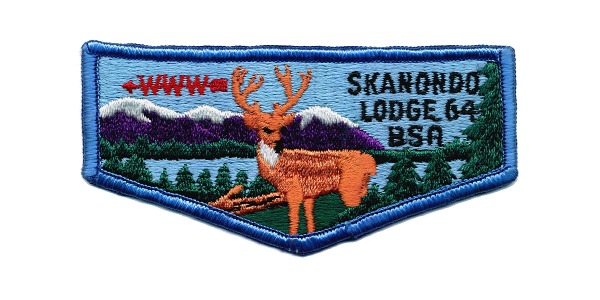
The S4 marked a new era for Skanondo Lodge. Everything about the patch was a departure from what came before and set the standard for nearly every lodge flap that would follow. Full embroidery, multiple colors, plastic backs (on some versions), straight lines, and a smaller size defined the Skanondo look from here on out. This was also the first Skanondo flap with BSA and/or the fleur-de-lis (FDL) on it signifying the link to the BSA (this was added to all lodge flaps and council strips sometime around the late ’70s / early ’80s).
Four variations of the S4 have been documented, all of which are shown above. Distinguishing cloth back from plastic back is easy enough, but the green vs. dark green distinction is quite another task. In some lighting, the colors look exactly the same. Even in the scans above, the difference is very slight. In the right lighting (daylight LED bulbs seem to work best), the difference is clear. Luckily, my father’s collection had both of the cloth backs, so I could figure out that I needed just the dark green plastic back (S4d). Bill Mulrenin had a plastic back S4 (marked S4b) for sale at the Kintecoying Trade-o-ree that seemed to have a darker shade of green than what I thought was my S4b (obtained from my brother) but I couldn’t be sure. It wasn’t until I got home a few days later that I could confirm that the set was complete.
Arapaho II lists the S4 as being from 1985. It is possible that this was the last year of issue, but there’s no possible way a patch with this many variations could have first been issued in 1985 with three more new flaps still to come before the end of the decade. Considering that the date it lists for the previous two flaps is 1972 (which would also be the likely issue date of the one before those), something is clearly off here.
This design extended well beyond just a pocket flap. A silk screen version was used on neckerchiefs (Blue Book designation N3) and t-shirts. And the patch design was used on a pin for the first time (that I am aware of, the Blue Book specifically does not catalog pins).
Skanondo 64 Pin – S4 Design, Error (“SKAHONDO”) (1980s)
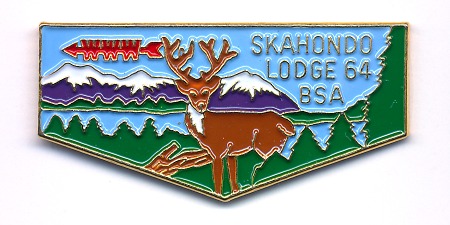
While slightly different from the patch, the pin design still captured the spirit of the design, perfectly representing Skahondo Lodge. Oops. Like the Hudson-Delaware Council 1985 Jamboree council strip pin, the back was a screw-type instead of the usual clasp back.
Skanondo 64 Pin – S4 Design, Corrected (1980s)
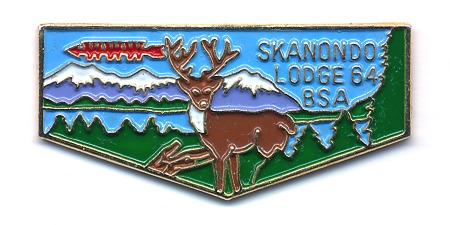
A corrected version was also issued. While based on the same source material, the corrected pin features a slightly different design and has slightly different colors. Both screw back and clasp back versions exist.
Skanondo 64 S5 (1980s) – 40 Years of Service
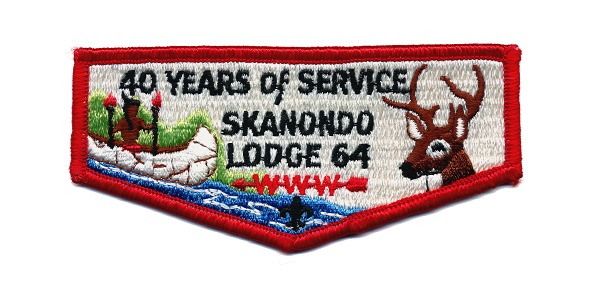
And now we revisit the “25 Years of Service” mystery from 1971. This time, it’s “40 Years of Service” on a patch issued right around 1986, which is consistent with the S3. And still doesn’t match anything else. What was the “40 years” based on? Inaccurate documentation? The previous patch alone? I have no idea. Half Moon also issued a 40th anniversary flap in 1986, so at least we’re together in that. Brotherhood in getting dates wrong, or something.
Skanondo 64 Pin – S5 Design (1980s)
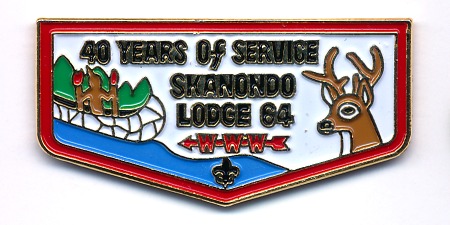
The S5 also has a corresponding pin. This time, the border is incorporated. And nothing is misspelled. Let’s see if we can keep that streak going…
Skanondo 64 S6 (1980s)
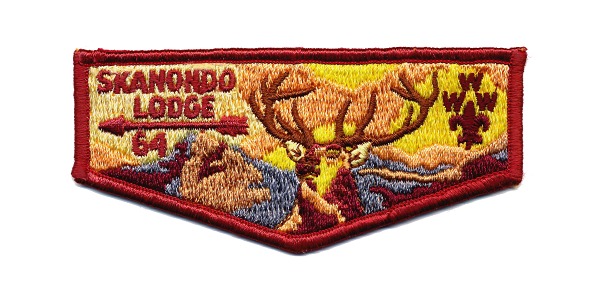
Take a moment to appreciate this patch. A majestic 12-point buck against a multicolored sky and towering peak. Lines and colors that shout “this belongs in a museum.” Take it all in. It doesn’t get any better than this.
Seriously, the S6 is the pinnacle of Skanondo artwork. And, as with most things on this page, there’s more to the story. The deer on this flap, right down to the pose, is nearly identical to the one used on Skanondo neckerchiefs from the 1950s (Blue Book designations N0.7 and N0.8). Why that is, I can’t say. The neckerchief may have been used for reference. Or they may both be derived from the same source material. It may even be a common generic deer design used by countless lodges since the early days of the Order. But this is definitely the same design on items produced 30 years apart.
Skanondo 64 Pin – S6 Design, Error (“GA”) (1980s)
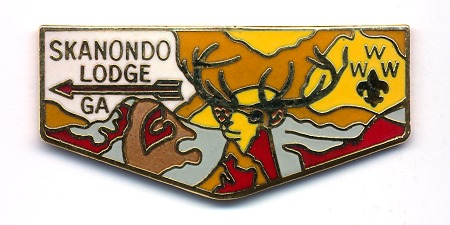
As with the previous two patches, the design is faithfully replicated on a pin, adapted for the smaller size but still capturing the essence of the artwork. Well, except for moving the lodge to Georgia. Time to set the “flaps since a spelling error on the pin” counter back to 0… I am not aware of a corrected version, but pins rarely show up on the secondary market.
Skanondo 64 S7 (1980s)
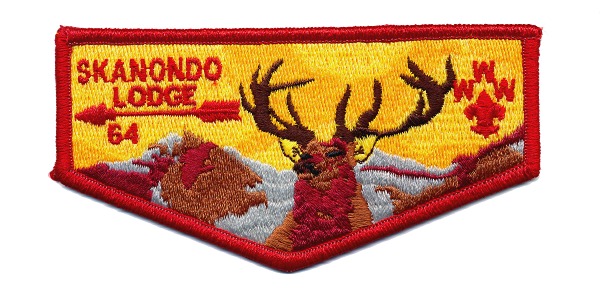
I’m just going to come out and say it – I don’t know what’s going on here. The next flap on the list uses the same design as the S6 with slightly different colors, flatter embroidery on the background, a much larger size, and a noticeably asymmetric point on the bottom edge. As with the F4, something clearly went wrong here. Are these failed prototypes? I have lots of questions but no answers.
Well, one answer. This flap was only issued at a single event in the late ’80s, making it one of the rarer Skanondo issues. As such, I had to find my own because my brother didn’t have one to trade. This marks the end of my family’s involvement with Skanondo Lodge until my ordeal.
Skanondo 64 S8 (1990) – OA 75th Anniversary 1915-1990
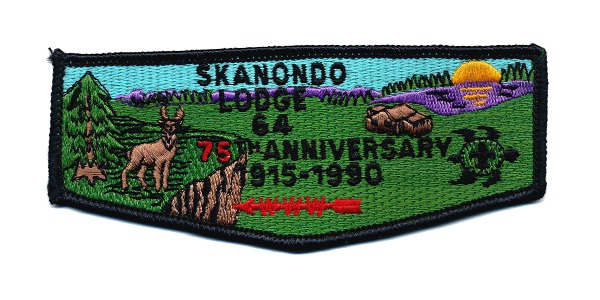
So, um, I think this speaks for itself. Skanondo Lodge celebrated the 75th anniversary of the Order of the Arrow with, um, this. This flat, misshapen, floppy (cloth backed) sea of green with lots of text and tiny details, including the main lodge at Camp Ranachqua. Let’s move on.
Skanondo 64 S9 (1991-1993)
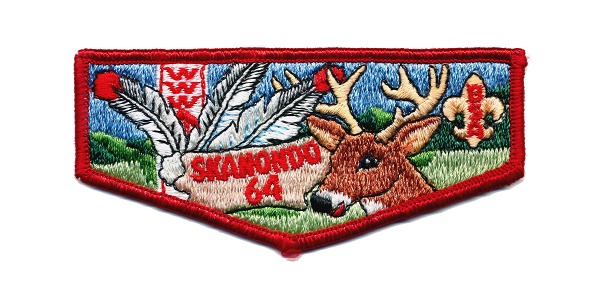
Here’s where I enter the picture. The S9 was the first Skanondo flap I was ever issued. The design is a departure from the more realistic artwork of the past and I can’t say I’m a fan. The S9 was last issued in June of 1993, but the design persisted until the very end. Several later flaps were based on this design and then there are the pins…
Skanondo 64 Pin – S9 Design (1991-1995)
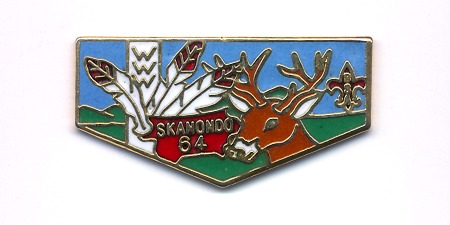
This was the last standard issue pin for Skanondo Lodge. Smaller than the previous pin issues, it still managed to faithfully recreate the design (I would say it actually looks better). And without any errors! This pin would continue to be sold at the trading post long after the corresponding patch was discontinued. No matter how many I bought, they never ran out. And I’ve still got a pile of them. There was just no escaping the S9 design.
Seriously, it followed you wherever you went, as evidenced here by this 1995 notice that I was behind on my dues. I’m not sure whether I ever paid them. According to a newsletter that fall, a lot of these notices were sent out in error. Maybe I was in good standing after all? I don’t have a membership card from 1995 and I remained on the mailing list (later transferred to the successor lodge) into 1998, so we may never know…
The Blue Book claims that the S9 was issued after the S11. This is incorrect – that note should be on the S10.
Skanondo 64 S11 (1993) – 1993 National Jamboree
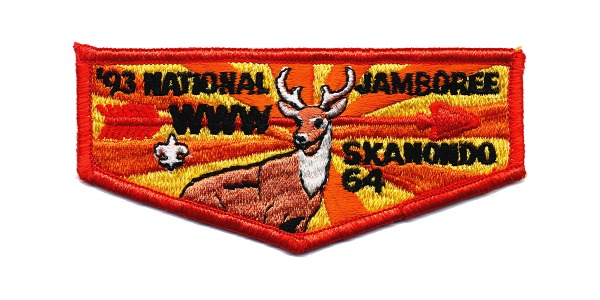
The S11 is the first event-specific flap ever issued by Skanondo Lodge. And it was a secret until the last minute (unless you attended the executive committee meetings, which, according to the meeting minutes that I never actually read until just now, almost nobody did – “WHERE ARE THE BROTHERS?”). Upon arrival at the 1993 National Jamboree on August 2, 1993, all youth OA members present were issued five of this patch at no cost. Or maybe it was the night before. Either way, this was a surprise issue that none of us were expecting. This was an all-new design, but what really mattered was just that it wasn’t the S9. We finally had a flap to call our own, and we got five without having to go to two years worth of events!
Did I say five? Yeah, about that… It turns out that we were actually due to receive six, not five. Word eventually got around and, when confronted, the adults admitted that they had been holding out on us. They claimed that they were worried that we would trade away all of our precious, new, not-S9 flaps and be left with nothing to take home with us. So they decided to help us by giving us the last one once we returned home, keeping it a secret the whole way as they had for the first five. Their plan, in a word, stunk.
Contrary to their expectations, we hadn’t been freely trading our newfound flaps. Having enough flaps to trade was highly unusual and we already knew to be very selective when making trades. But the first-ever (and last-ever, but we didn’t know that at the time) Skanondo Lodge Jamboree flap? That meant more to us than it meant to anyone we would trade with. We only had five of them and once they were gone, that was it.
For me, it didn’t leave me much to work with. I would obviously need one to put on my uniform (where it remains to this day). And one for the collection (shown above). My brother would want one, of course. And you always want to keep a big trade chip in reserve, so one more would need to be saved for a big deal that probably wouldn’t present itself at the Jamboree. That left one that could be freely traded for something nice. And that’s exactly how many I traded.
We ended up getting our final Jamboree flap near the end of the Jamboree instead of after returning home. But most of the trading opportunities had passed. Mine just went home with me. And it’s still here.
Based on the number of flaps issued per person and the contingent size (two 40-person troops), there should be fewer than 500 of these flaps. Not all Jamboree attendees were OA members, so that number could be low as 300. But that assumes that the adults didn’t have piles of extras stashed away somewhere and that is not a safe assumption. Embezzlement was a popular pastime of council executives at the time, after all. Also, see the F2. So who knows? It’s safe to say that the print run is probably closer to that of a single-year issue than a single-event issue.
Skanondo 64 S10 (1993-1995)
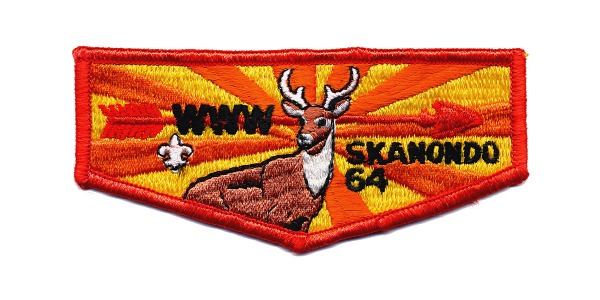
The S10 is the same as the S11 except the “’93 National Jamboree” text is omitted. While these were likely produced at the same time as the S11, they were not issued until the night of August 21, nearly three weeks later. The previously mentioned executive committee meeting minutes seem to indicate that this flap was intended to debut at the June ordeal but was delayed for unknown (to me) reasons.
Skanondo 64 S12 (1994) – NOAC 1994 Fundraiser
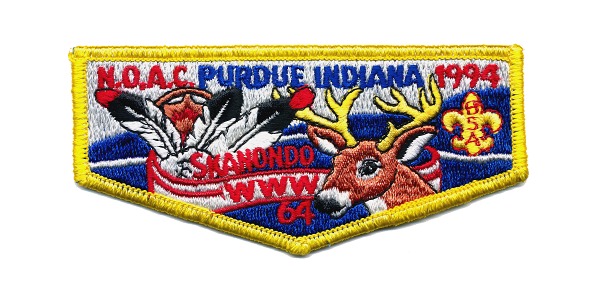
Skanondo 64 S13 (1994) – NOAC 1994 Fundraiser
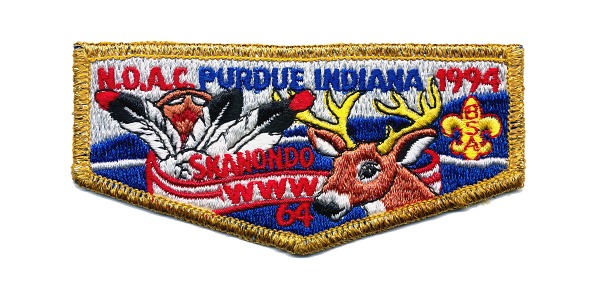
These next two marked another first for Skanondo Lodge – the first flaps that could be freely purchased without attending an event. These were sold via mail as fundraisers for Skanondo’s trip to the National Order of the Arrow Conference in 1994 (the first time they attended as a formal contingent and, of course, also the last). Sadly, I did not make a copy of the order form before sending it in, but I believe the prices were something like $5 for the yellow border (S12) and $10 for the gold mylar border (S13). That was pretty pricey for the time. I still bought a few of each to have something to trade.
Arapaho II lists the print run for these as 240 for the yellow border and 100 for the gold mylar border.
Skanondo 64 S15 (1994) – NOAC 1994 Contingent
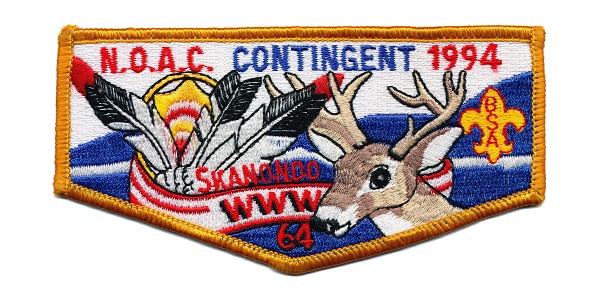
There is no S14. The Blue Book goofed and erroneously included (and quickly deleted) a tan bordered version of the S12/S13 (evidently combining the fundraiser and contingent flaps), so we skip to S15 for the flap that was made for the people who actually went to NOAC in 1994. Initially, I was going to be among them. My troop’s plan for Philmont in 1994 had seemingly fallen through, so this was the next best thing. Then Philmont was back on and I ditched NOAC and never looked back.
The NOAC Contingent flap uses the same design as the fundraisers only in a larger size with flatter embroidery and no plastic back. And it says “CONTINGENT” at the top in big blue letters. This was the first Skanondo flap since the S8 in 1990 that did not conform to the standard format set in the 1980s.
Contingent members were told by the adults not to trade this flap with lodge members who did not attend NOAC. This, of course, was not binding and I found someone to trade with at the Section NE-2B conclave the following month.
Skanondo 64 Pin – S15 Design (1994)
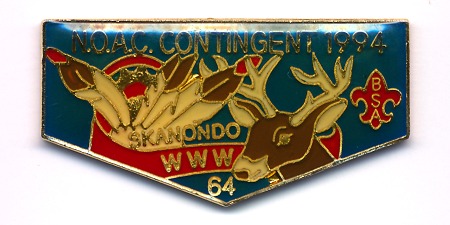
This design was also used on a pin, the last Skanondo issue that I am aware of. Unlike all previous Skanondo pins, this one had a clear coating that soon yellowed horribly. They did the same thing to the Jamboree council strip pins the year before. The ’90s was full of bad ideas…
Skanondo 64 F5 (1995) – 1995 Conclave Service Lodge
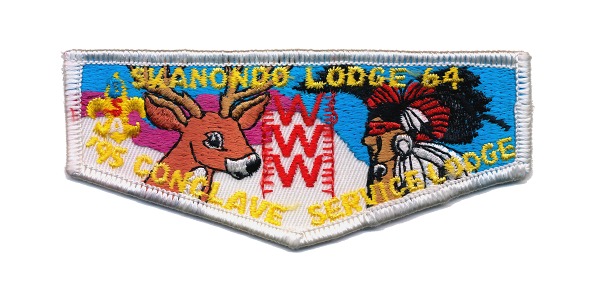
We’ve reached the point where I have little more to add. Skanondo Lodge hosted the Section NE-2A conclave at Camp Ranachqua on 8-10 September 1995. This would be the final conclave hosted or attended by Skanondo Lodge and its first as part of Section NE-2A. The final Skanondo ordeal weekend took place the following weekend, likely delayed a month to occur after the conclave rather than at the end of Summer Camp.
As for me, I had just started college and was unable to attend. My time as an active member of Skanondo Lodge was over. I have no information about how this flap was distributed.
The patch itself is odd in that is has a partially embroidered background – the blue and magenta are embroidered but the white is bare twill. That’s enough to get it an F designation instead of S. Otherwise, its construction is in line with most Skanondo flaps from the previous decade plus. All that white is a pain to scan though.
Skanondo 64 F6 (1996) – 64 Years of Service
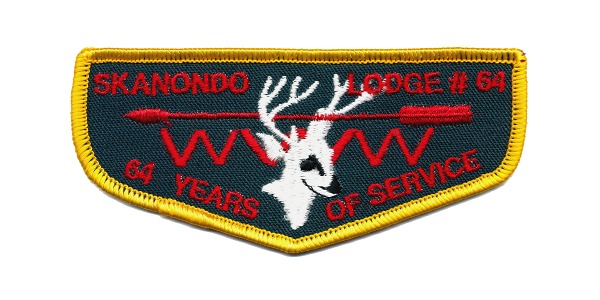
It’s been quite a journey, but we’ve reached the end. The merger of the Hudson-Delaware, Dutchess County, and Rockland County councils was complete as of 1 January 1996. Skanondo Lodge went out with a bang at the Winter Banquet later that month, bringing back the design from the first flap (specifically, the F1c variation), giving it a modern makeover, and adding the “64 Years of Service” line to match the “25 Years of Service” line on the S3, released 25 years earlier. And now we’re more than 25 years past that. Time sure flies.
Friends of mine tried to entice me to attend the Winter Banquet with the promise of a rare lodge flap. They knew what buttons to push, but I turned them down anyway. I had my Eagle Scout Board of Review the day before the scheduled date for the Winter Banquet and then I was set to return to college. That scheduled date, by the way, was January 7, 1996, at the height of the Blizzard of 1996. I have a feeling it was rescheduled.
Skanondo 64 S16 (1996) – NOAC 1996 Fundraiser
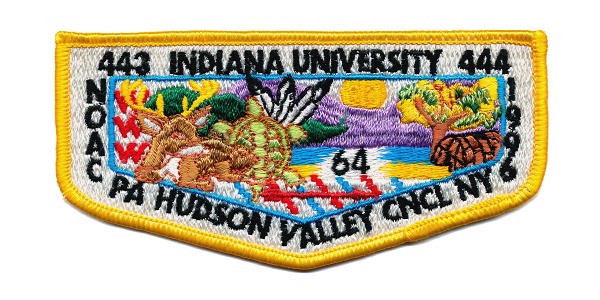
Skanondo 64 S17 (1996) – NOAC 1996 Fundraiser
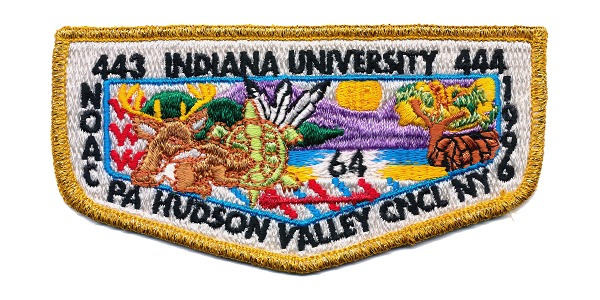
Skanondo 64 S18 (1996) – NOAC 1996 Fundraiser
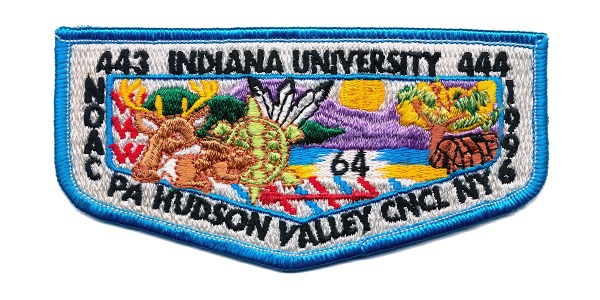
And then there’s this. Classified under all three legacy lodges of Nacha Nimat 86, these were issued by the Hudson Valley Council to represent their as-yet-unnamed new lodge that would be attending NOAC in 1996. The design shows the numbers and totems of the three legacy lodges but not their names. I’m guessing these were fundraisers based on the similarity to the S12 and S13. The NOAC contingent would have proper Nacha Nimat flaps.
Arapaho II lists the print run for these as 400 for the yellow border and 100 for the gold mylar border. The blue border version is not listed (as of the 1997 edition).
Skanondo ZS1 (1996) – Private Issue
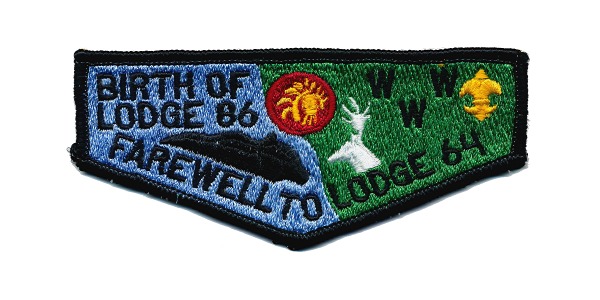
I had originally omitted this one because it isn’t an official issue and can’t be confused with one. And I didn’t think I would be able to find one. As it turned out, it took less than a month for one to show up for sale. I don’t know anything about this patch beyond what’s in the Blue Book. It is listed as a private issue and it definitely looks the part. The lines aren’t straight, the stitching is rough, and the backing looks like it’s about to fall off. It has the feel of a patch that has been through the wash a few times.
Beyond that, the patch speaks for itself: “Birth of Lodge 86, Farewell to Lodge 64.” I don’t know who had it made, how many were made, or how they were distributed. It sure wasn’t through official channels as there was no mention of it in any of the early Nacha Nimat newsletters. All I can say with any certainty is that, based on the presence of the new lodge number and totem, it was made after March in 1996. Because…
The details of the merger that would form Nacha Nimat 86 were worked out at meetings in March of 1996 at a location consistently referred to as “Steward Airport.” This would seem to be a misspelling of Stewart Airport. 2,400 flaps for the new lodge were ordered in order to outfit its estimated 800 members (limit 3 per person), as well as 1,000 pins. Gee, I hope that propensity for misspelling doesn’t manifest itself in the first flap…
Nacha Nimat S1 (1996) – Error (“MIMAT”)
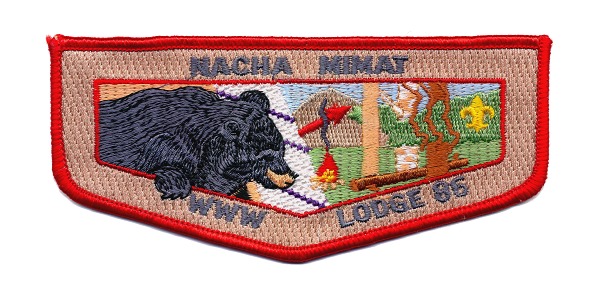
And there it is. This was corrected for the NOAC 1996 flap and the jacket patch version, but I do not know about the pin. The Blue Book then took it one step further by misspelling the misspelling as “MIWAT” in published versions up to the 6th edition, including all current online versions. A fix has been on the way since 2006.
Addendum
The end of Skanondo Lodge wasn’t the end of its influence on patch designs. Several releases from Nacha Nimat 86 have featured the totems of its legacy lodges, much like the NOAC 1996 fundraiser patches did.
Nacha Nimat S9 (2001) – Fifth Anniversary
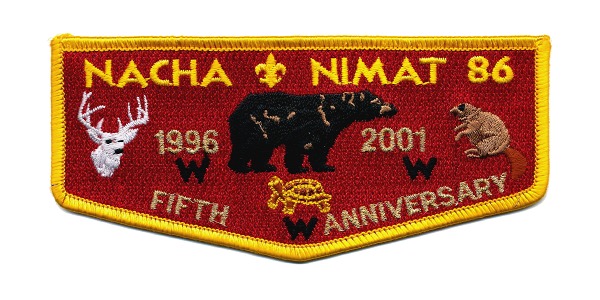
Five years after the merger, Nacha Nimat released a Fifth Anniversary flap with its totem and the totems of Skanondo 64, Nooteeming 443, and Munsi 444. This would be the only time the legacy lodge totems would be featured on a Nacha Nimat flap.
Nacha Nimat S16/X4 (2004) – NOAC 2004 Trader
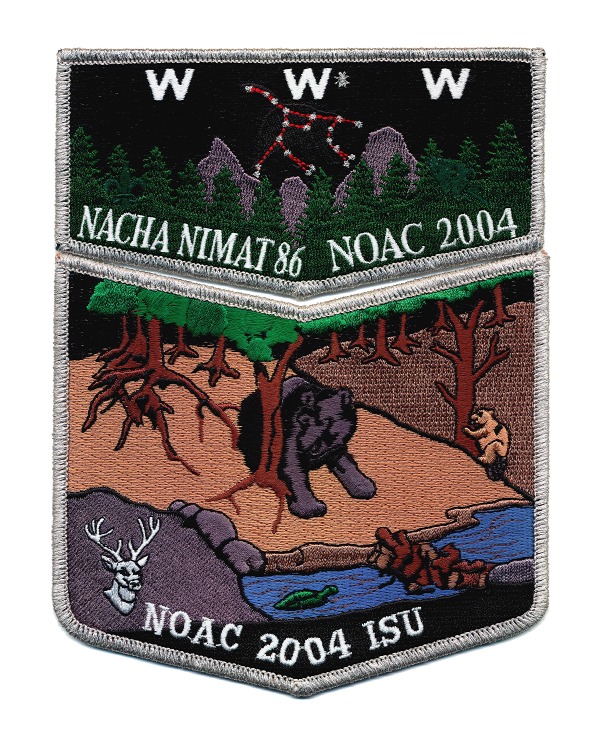
Three years later, the companion pocket patch for the NOAC 2004 flap once again featured the quartet of totems. This patch was made in silver-bordered Trader (shown above) and gold-bordered Delegate (not shown) varieties.
Nacha Nimat S54/X34 (2015) – OA Centennial
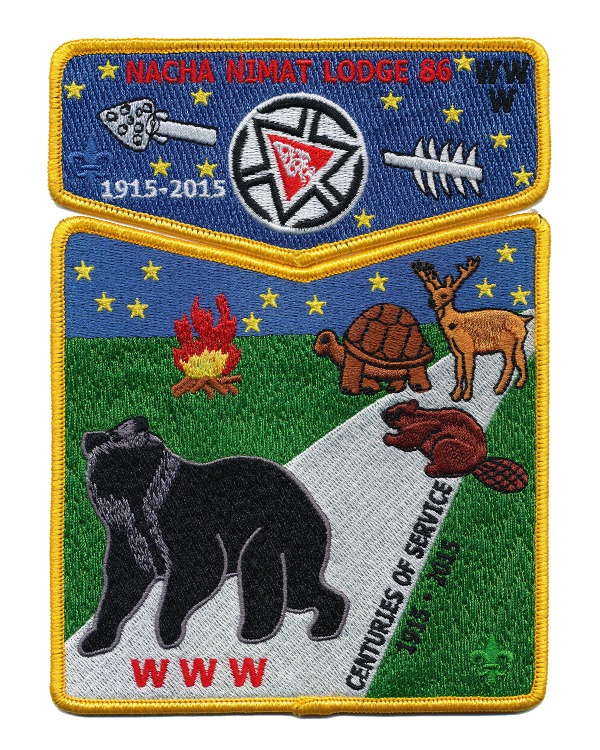
To celebrate the 100th anniversary of the Order of the Arrow, Nacha Nimat released this patch set that once again featured its totem with those of its predecessors on the companion pocket patch. This would be the last time the four would share a patch.
Nacha Nimat HF1 (2015) – Skanondo Lodge 1932
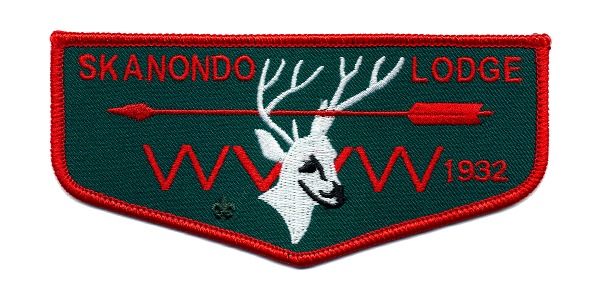
Nacha Nimat HS1 (2015) – Skanondo Lodge 64 1932
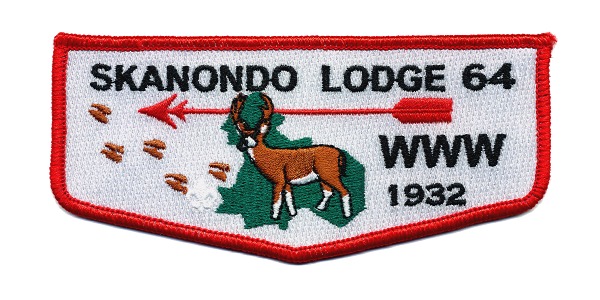
Also as part of the OA Centennial, Nacha Nimat released an 8-patch Centennial Set that included reproductions of the first two Skanondo flaps. As with the Skanondo F6, the F1c variation was used as the basis for the F1 reproduction. According to PatchScan, 100 copies were made of each: HF1 HS1.
Nacha Nimat eS2016-1/X38/eX2016-1/eX2016-2/eX2016-3 (2016) – 20th Anniversary 5-Piece Set (Sewn)
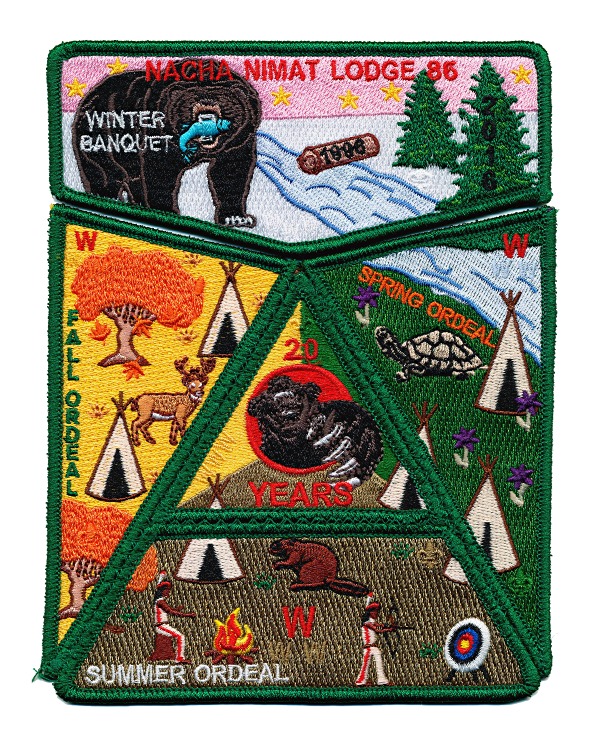
Finally, for the lodge’s 20th anniversary, Nacha Nimat released a 5-patch set featuring each of its predecessors’ totems on separate segments. The pocket section was available as individual patches (partial set shown below) or a pre-sewn 4-patch set (shown above). These are the final appearances of the Skanondo, Nooteeming, and Munsi totems on Nacha Nimat memorabilia that I am aware of.
Nacha Nimat eS2016-1/X38/eX2016-3 (2016) – 20th Anniversary 5-Piece Set (Partial)
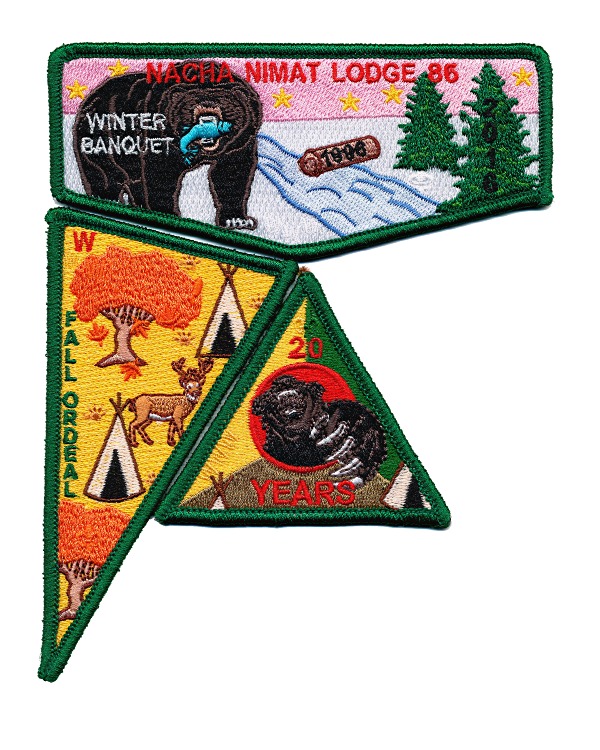
Mahicantuck S1 (2022) – First Flap
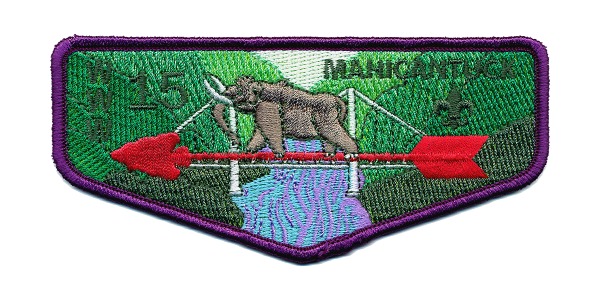
On its 25th anniversary, Nacha Nimat 86 faced its impending demise. After merging with Ktemaque 15, it became part of Mahicantuck 15. The release of Mahicantuck’s first flap in April of 2022 almost certainly closed the door on 90 years of Skanondo’s history and legacy of influence. Considering Ktemaque’s extensive history of lodges it can trace back to, it seems unlikely that any legacy totems beyond those of Nacha Nimat and Ktemaque will appear on Mahicantuck issues. A gold-bordered Charter Member version was also issued, available only to active members. For those of us who haven’t paid their dues in 25+ years, you can buy the S1 direct from the Greater Hudson Valley Council and avoid the eBay markup.
Mahicantuck S4/X2 (2022) – NOAC 2022 Delegate (“MAHICANTUK”)
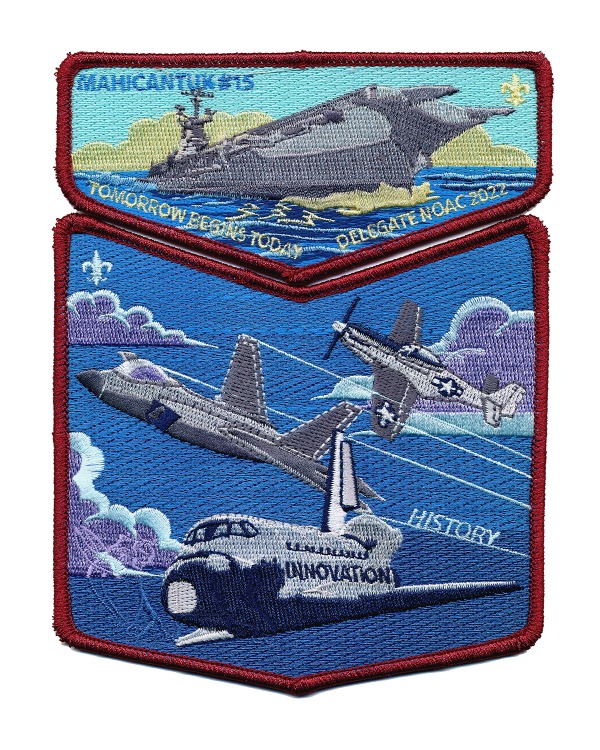
Both the Greater Hudson Valley Council and Mahicantuck Lodge managed to issue their first patches without spelling errors following the merger in 2021, seemingly breaking the ages-old curse. And with that, Mahicantuk Lodge headed off to NOAC 2022. I suppose that’s not the least fortunate error they could have made, but it was subtle enough to not require an emergency correction. And I had such high hopes for this one… Delegate and trader versions were produced, both with the same error. That just leaves the Greater Hudson Valley Council as the only council or lodge descended from the Orange-Sullivan Council to have never misspelled its name on a patch or pin. No pressure…

























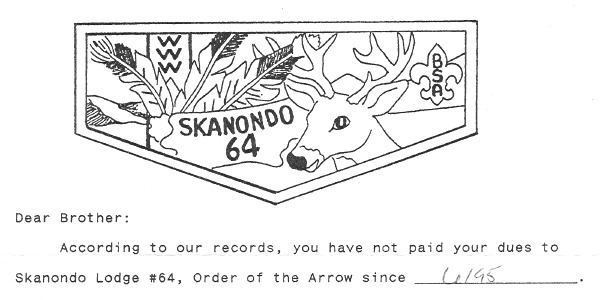
Very much enjoyed reading your article. I have been collecting Skanondo issues for quite sometime. It is nice to have some of the back story on these issues.
I was unaware of the amount of pins issued. I do have in my collection both the S4 error and the S4 corrected. None of the others. You have successfully lengthened my needs list. LOL
The flaps that I am still on the hunt for is the S10, S11, S13, and the X1 which is the elangomat dangle.
WWW
Frank
Thanks for the great trip down memory lane. A little story about the 5 patch distribution of S11 at the ’93 Jamboree. I believe that we actually ordered less patches than we actually needed. I was a 3rd ASM at the Jamboree and still involved in the lodge at the section level but was not involved in the ordering of the patches as I left for college in 1992. As a (young) adult leader, I was only issued 3 of the patches because we were short. I recently acquired my dad’s patch collection (he was the SM of one of the 93 Jamboree troops) and he didn’t have a single one besides the ones on the uniform. He did, however, have a number of the CSPs from the 89 and 93 jamborees.
If memory serves me correctly, this patch, and a couple before, were designed by Stan Ferguson, a fixture of the HDC and Skanondo Lodge for many years.